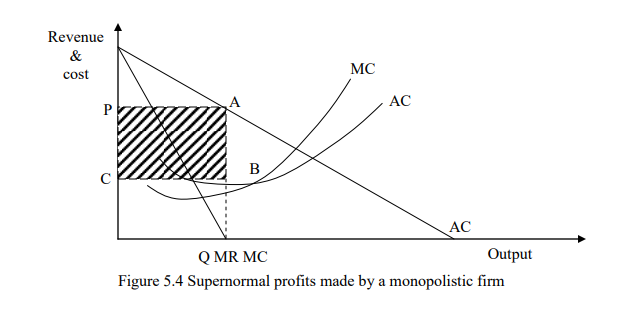Monopolies are usually associated with economies of scale because of the large size of the market controlled by the firm. Economies of scale imply lower unit’s costs of production. It is likely that the consumer will benefit from this cost effectiveness through lower prices from a monopoly supplier.
A monopolist like any other firm finds profit maximizing level of output where the marginal revenue is equal to marginal cost as
shown in Figure 5.4. Monopoly firm maximizes profit at the level of output Q where the necessary and sufficient conditions of profit maximization are satisfied. The super normal profits earned by the monopolist are represented by the shaded area PCBX. This
monopolist profit will persist in the long run since the are barriers to the entry in the industry. In the long run the monopoly can expand or use the existing plants at any level that will maximize profit. Owing to the existence of barriers it is unnecessary for the
monopolist to reach the optimum scale of production which corresponds to the minimum point of the long run average curve.

Sources of monopoly power
Legal barriers This takes the form of statutory monopolies or patents i.e. monopolies established by an Act of parliament and patent meaning that a firm is protected from competition of new firms.
Products differentiation barrier This may be in form of product uniqueness, advertisements and branding where an existing monopolist may exploit his position as a supplier of an established products which the customer is persuaded to believe that it is
the best.
Economies of scale barriers could arise where existing firms are already operating on a vast scale production and enjoying technical economies of sale.
Transport cost and tariff barriers Some firms may enjoy local monopoly position arising from the ability to sell more cheaply in their own localities than other firm. Such firms can therefore rise prices in their local markets above the production cost by an amount
that does not exceed transport cost close of firm in other localities with similar production cost
Advantages of monopolies
- Economies scale
- No wastage of resources
- Price stability since monopolists are price makers
- Ability to carry out research and development to improve on their product
Disadvantages
- Diseconomies of scale arises in case the firm grows in a very large size, exploits the economies of scale and fails to achieve the
targeted economies of scale. - Inefficiency since there is no competition
- Lack of motivation though the firm is in a better financial position to research and develop there product the monopoly may fail to do so since there is no competition or a challenging firm.
- Consumers‟ exploitation .This is the most notorious practice of monopoly. This is done through overpricing and price
discrimination of their products.
Price Discrimination
This exists where the same product is sold at different prices to different buyers. This depends on the tastes and preferences of the consumers, different periods of the firm, consumers‟ income etc. These factors will give rise to a demand curve with different
elasticities in different areas in the markets for the firms. Price discriminates is easily implemental by a monopolists since he controls the whole supply of a given good. There are two necessary conduction for price discrimination to take place:
1. The monopolist must effectively separate markets. If he has not separated the market the customers in the low price market will buy and sell the commodities those consumers in the higher price market.
2. The price elasticity of demand for the two markets must be different so that profitability will be realized. At every price the demand in any market must be elastic than the other where the low priced market have a more elastic demand than the high priced market. By selling the quality dined by the equation MC and MR at different price the monopolist realizes a higher total revenue and profits, the
monopolists realizes a higher total revenue and profits as compound to charging uniform prices.
N/B: suppose that a monopolist has two markets M1 and M2 the profit in each market maximized by equating marginal cost to the corresponding marginal revenue i.e.
In the first market; MR1=MC1
In the second market; MR2=MC2
That mean monopolist will maximize profit by equating the common market cost with the individual market revenues as MC=MR1=MR2
